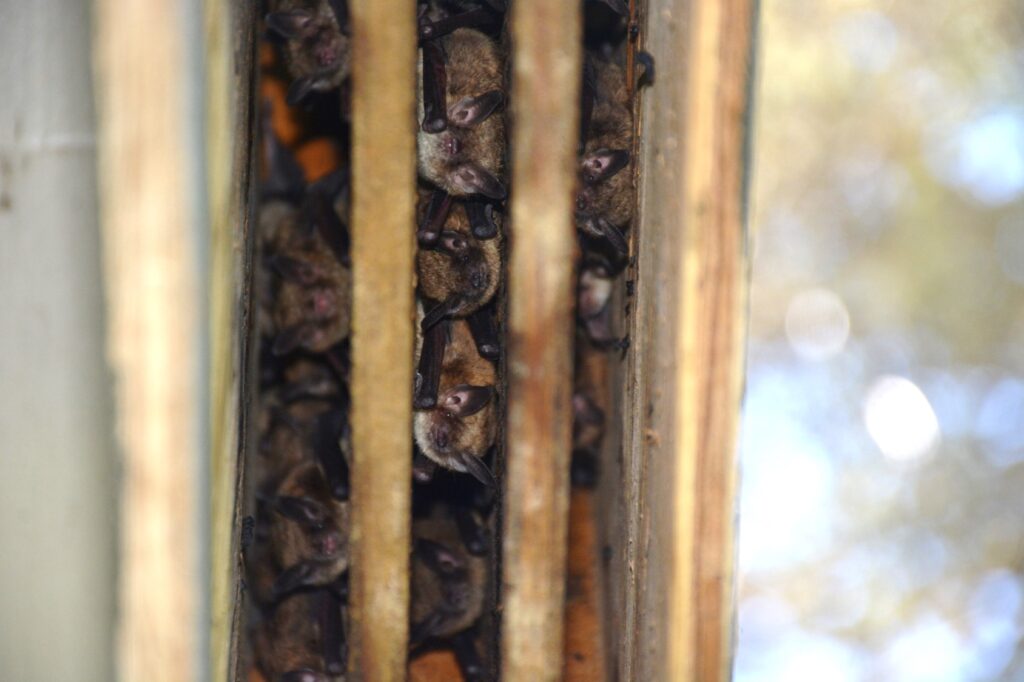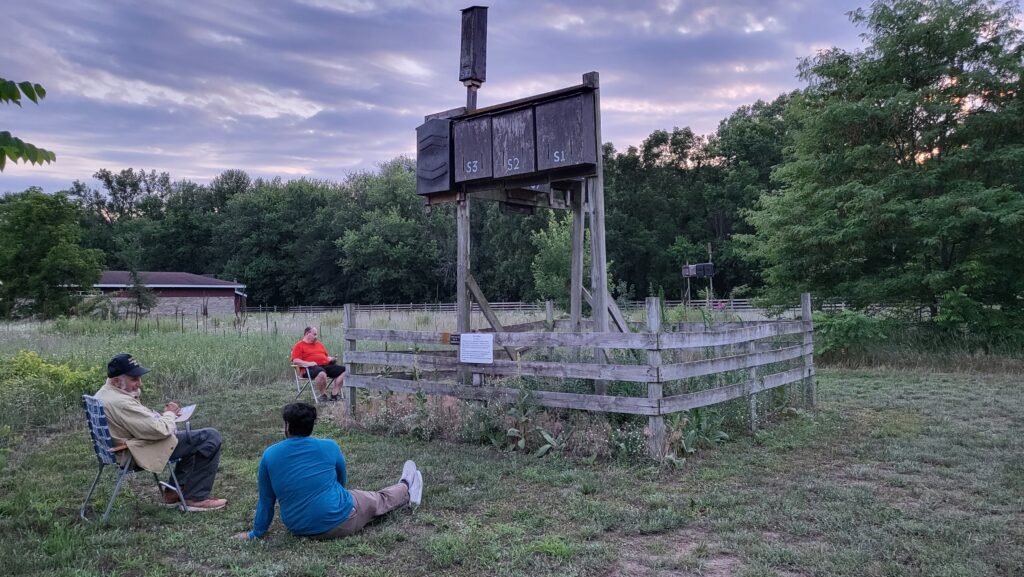
Protect Your Bats!
A healthy bat population is good for your land. Little brown bats like the ones in this picture will readily roost in bat houses in summer. Learn more about what you can do to help bats on your land. Photo courtesy of H. Kaarakka, WDNR.
By Denise Thornton
Wisconsin landowners who want to take steps to protect the wildlife on their property, should not forget about bats. As the only winged mammals, they play a crucial role in almost every ecosystem on the planet — including in our own state. “The eight species of bats that live in Wisconsin are insectivores, provide really important pest control,” says DNR Conservation Biologist, Heather Kaarakka, “Because they have a wide range of diet, they help control not only human pests like mosquitos, but also agricultural pests and forest pests as well. They are good to have around!”

Wisconsin’s eight species include four who hibernate in underground areas to survive the cold winter months when there is nothing to eat. The other four species migrate to warmer climates for the winter.
WHITE NOSE SYNDROME PUTS BATS AT RISK
It’s difficult to come up with a precise number of bats in the state, but those species who hibernate have been hit hard by a fungal disease called White-nose Syndrome (WNS) which arrived in the United States in 2006. “It spread quickly from hibernation site to hibernation site, killing millions of bats across the continent. It arrived in Wisconsin in 2014. Since then, WNS has caused declines of anywhere from 70 to 100 percent of the bats hibernating in a site,” says Kaarakka.
“Some species have been highly impacted,” she continues. “We just don’t see the northern long-eared bat or the tricolored bat (Wisconsin’s smallest bat) underground much anymore. The little brown bats were one of the most common species in Wisconsin, and they saw significant declines.”
We know this thanks to two citizen science projects that monitor bats across Wisconsin. In one project, volunteers are trained to use acoustic detectors which record the ultrasound of bats as they echolocate. The volunteers either walk, drive, or paddle with a detector.

“Just like you can ID a cardinal versus a chickadee with bird song apps on your phone, we can identify a little brown bat versus a big brown bat based on their echolocation calls,” says Kaarakka. “Folks have been doing these surveys for over 15 years, and we can get a sense of where bats were prior to WNS and what the landscape looks like now that WNS is permanently established in Wisconsin.
There is also a summer roost monitoring project where folks with bat houses or barns, where bats like little brown and big brown bats are roosting, conduct emergence counts. These volunteers will sit outside in the evenings and count the bats as they fly out of their roost sites. “Like the acoustic studies,” says Kaarakka, “we can get a sense of where they are roosting, the types of roosts they are using, and, most crucially, how many bats are in these sites.
“Every time the bats go back into hibernation in the fall, they are exposed to the fungus that causes WNS,” she continues. “We have a sense of what has happened to the little brown bat population across the state thanks to summer roost and acoustic surveys, and we can see some glimmers of hope. The summer sites that folks monitor have started to increase slightly. For example, folks who have been monitoring a bat house may have watched the population go from 200 bats to 30 bats in a year, and now it is slowly increasing and approaching 100.”
HOW LANDOWNERS CAN HELP BATS
In summer when bats are on the landscape, there are critical habitats that they need to survive. They depend on a foraging habitat where they can capture a lot of insects. “Bats have high metabolisms,” says Kaarakka, “and can eat upwards of a thousand mosquito-sized insects in an hour.” Bats also need roosting habitat. Because they are nocturnal, they need protection when they sleep during the day. “They are looking for tight crevices or leaf clusters in trees. The types of roosts they will use varies by species. Some species forage and roost in forests. Some species will readily use artificial structures like bat houses. Some use a tree for roosting and might forage over water.”

Kaarakka says there are important ways that landowners can help the bats on their property. Some species of bats roost in dead trees that have peeling bark, or cavities in them. Keeping those dead trees (snags) that are not a human safety hazard will provide habitat. “Most of our bats use hardwood trees for roosts,” she explains. “Hardwoods are more likely to have those cracks and crevices or even peeling bark that bats are looking for. It’s good to manage wooded property such that there is a wide range of tree species and ages so, as some fall down and decay, others are becoming available as roost sites.”
Another way to benefit bats is to keep areas around creeks and rivers clear. These are both important migratory corridors and foraging areas. “For folks who don’t have woods but are close to water, consider putting up one or more bat houses. Little brown and big brown bats in particular are known to use artificial structures.” Kaarakka says the WDNR has a site where you can learn about the types of bat houses and where to put them.
Bats are long-lived for their size. “While a mouse may live a year or two, little brown bats can live up to 30 years,” Kaarakka says. “If you think about it, they spend more than half their life asleep. They are in true torpor with extremely low heart rate and metabolism in the winter and are asleep for a portion of each summer day as well.”
Bats also have high site fidelity, returning to the same locations every year. “Once you have an established colony of little brown bats in a bat house, for example, the same bats will be coming back again and again,” Kaarakka says. The females give birth to pups in early to mid-June. The pups are flightless for a few weeks, then they learn how to fly, and in mid-July they begin to disperse, but the females will return to the maternal roost and share the same bat house with a number of generations. “Because they are long-lived and generally only have one pup a year, that makes a disease like WNS able to almost wipe out colonies. It is really hard for them to rebound.”

Bats often fly long distances from hibernating sites to roosting sites. Suitable hibernation sites in Wisconsin are a limited number of caves, mines, and tunnels, so bats congregate in the winter and disperse in the summer. “That is one of the biggest gaps in our knowledge about Wisconsin bats,” says Kaarakka. “But through tagging efforts, we have found that bats can go from 30 to 150 miles from a summer site to their winter hibernation site.”
COMMON MISCONCEPTIONS
Bats have commonly been thought of as being likely to spread rabies. “The incidence of rabies in the wild bat populations is less than one percent, but that doesn’t mean someone couldn’t get rabies from a bat,” Kaarakka says. “There are ways to prevent direct interaction and possible exposure. One is: Never handle a bat — especially without gloves. If you need to remove a bat from the house, cover it with a box and slide something underneath it, then release the bat outside. Don’t just try to grab it.”
Kaarakka also discounted the idea that bats have any interest in getting tangled in a person’s hair. “The reason bats may swoop close to your head if you are outside in the evening is that you are attracting insects, like mosquitos and midges. These insects are their food source.”
If you would like to find out more about bats, these links can help you learn about bat reproduction, other frequently asked questions, and how to get involved in bat monitoring.
